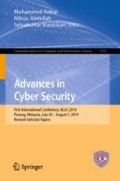Abstract
Numerous security researchers have a growing interest in the vulnerabilities of the in-vehicle Controller Area Network (CAN) bus system to cyber-attacks. The adversaries can leverage these vulnerabilities in manipulating vehicle functions and harming the drivers’ safety. Some security mechanisms proposed for CAN bus in detecting anomalies have favoured over the one-class classification, where it constructs a decision boundary from normal instances. Nevertheless, the accuracy performance of the classifier is highly influenced by the data representation. Judging from this fact, this paper analyses the advantage of utilizing different feature scaling technique as in to obtain higher classification accuracy of the classifier algorithms. To serve this purpose, the CAN bus datasets in this paper are scaled using standardization, min-max, and quantile, and are evaluated using one-class classifier model used in automotive CAN bus. The results exhibit that integrating different feature scaling techniques could greatly enhance the classification accuracy of the classifiers.
Access this chapter
Tax calculation will be finalised at checkout
Purchases are for personal use only
References
Sakiz, F., Sen, S.: A survey of attacks and detection mechanisms on intelligent trans-portation systems: VANETs and IoV. Ad Hoc Netw. 61, 33–50 (2017)
Miller, C., Valasek, C.: Remote exploitation of an unaltered passenger vehicle. Black Hat USA (2015)
Koscher, K., et al.: Experimental security analysis of a modern automobile. In: 2010 IEEE Symposium on Security and Privacy (SP), pp. 447–462 (2010)
Hoppe, T., Kiltz, S., Dittmann, J.: Security threats to automotive CAN networks – practical examples and selected short-term countermeasures. In: Harrison, M.D., Sujan, M.-A. (eds.) SAFECOMP 2008. LNCS, vol. 5219, pp. 235–248. Springer, Heidelberg (2008). https://doi.org/10.1007/978-3-540-87698-4_21
Hoppe, T., Kiltz, S., Dittmann, J.: Applying intrusion detection to automotive it-early insights and remaining challenges. J. Inform. Assur. Secur. (JIAS) 4(6), 226–235 (2009)
Martinelli, F., Mercaldo, F., Nardone, V., Santone, A.: Car hacking identification through fuzzy logic algorithms. In: IEEE International Conference on Fuzzy Systems, Naples (2017)
Tomlinson, A., Bryans, J., Shaikh, S.A.: Using a one-class compound classifier to detect in-vehicle network attacks. In GECCO 2018 Companion: Genetic and Evolutionary Computation Conference Companion. ACM, Kyoto (2018). https://doi.org/10.1145/3205651.3208223
Weber, M., Klug, S., Sax, E., Zimmer, B.: Embedded hybrid anomaly detection for automotive CAN communication (2018)
Xing, Y., Lv, C., Wang, H., Cao, D. Recognizing driver braking intention with vehicle data using unsupervised learning methods (2017)
Loukas, G., Vuong, T., Heartfield, R., Sakellari, G., Yoon, Y., Gan, D.: Cloud-based cyber-physical intrusion detection for vehicles using deep learning. IEEE Access 6, 3491–3508 (2017)
Nawi, N.M., et al.: The effect of pre-processing techniques and optimal parameters selection on back propagation neural networks. Int. J. Adv. Sci. Eng. Inform. Technol. 7(3), 770–777 (2017)
Kumar, D.A., Venugopalan, S.: The effect of normalization on intrusion detection classifiers (Naïve Bayes and J48). Int. J. Future Revolut. Comput. Sci. Commun. Eng. 3, 60–64 (2017)
Kang, M.J., Kang, J.W.: Intrusion detection system using deep neural network for in-vehicle network security. PLoS One 11(6), e0155781 (2016)
Wasicek, A., Weimerskirch, A.: Recognizing manipulated electronic control units (No. 2015-01-0202). SAE Technical Paper (2015)
Taylor, A., Leblanc, S., Japkowicz, N.: Anomaly detection in automobile control network data with long short-term memory networks. In: 2016 IEEE International Conference on Data Science and Advanced Analytics (DSAA), pp. 130–139 (2016)
Pan, M., Zhang, J.: Quantile normalization for combining gene-expression da-tasets. Biotechnol. Biotechnol. Equip. 32(3), 751–758 (2018)
Upender, B.P., Dean, A.G.: Variability of CAN network performance. In: Proceedings of the 3rd International CAN Conference ICC (1996)
Taylor, A., Japkowicz, N., Leblanc, S.: Frequency-based anomaly detection for the automotive CAN bus. In: 2015 World Congress on Industrial Control Systems Security (WCICSS), pp. 45–49. IEEE (2015)
Lokman, S.F., Othman, A.T., Bakar, M.H.A., Razuwan, R.: Stacked sparse autoencoders-based outlier discovery for in-vehicle controller area network (CAN). Int. J. Eng. Technol. 7(4.33), 375–380 (2018). https://doi.org/10.14419/ijet.v7i4.33.26078
Hicks, S.C., Okrah, K., Paulson, J.N., Quackenbush, J., Irizarry, R.A., Bravo, H.C.: Smooth quantile normalization. Biostatistics 19(2), 185–198 (2017)
Hansen, K.D., Irizarry, R.A., Wu, Z.: Removing technical variability in RNA-seq data using conditional quantile normalization. Biostatistics 13(2), 204–216 (2012)
Monot, A., Navet, N., Bavoux, B.: Impact of clock drifts on CAN frame response time distributions. In: ETFA2011, pp. 1–4. IEEE (2011)
Potter, K., Hagen, H., Kerren, A., Dannenmann, P.: Methods for presenting statistical information: the box plot. Vis. Large Unstr. Data Sets 4, 97–106 (2006)
Moya, M.M., Hush, D.R.: Network constraints and multi-objective optimization for one-class classification. Neural Netw. 9(3), 463–474 (1996)
Ghafoori, Z., Erfani, S.M., Rajasegarar, S., Bezdek, J.C., Karunasekera, S., Leckie, C.: Efficient unsupervised parameter estimation for one-class support vector machines. IEEE Trans. Neural Netw. Learn. Syst. 29(10), 5057–5070 (2018)
Author information
Authors and Affiliations
Corresponding author
Editor information
Editors and Affiliations
Rights and permissions
Copyright information
© 2020 Springer Nature Singapore Pte Ltd.
About this paper
Cite this paper
Lokman, SF., Othman, A.T., Bakar, M.H.A., Musa, S. (2020). The Impact of Different Feature Scaling Methods on Intrusion Detection for in-Vehicle Controller Area Network (CAN). In: Anbar, M., Abdullah, N., Manickam, S. (eds) Advances in Cyber Security. ACeS 2019. Communications in Computer and Information Science, vol 1132. Springer, Singapore. https://doi.org/10.1007/978-981-15-2693-0_14
Download citation
DOI: https://doi.org/10.1007/978-981-15-2693-0_14
Published:
Publisher Name: Springer, Singapore
Print ISBN: 978-981-15-2692-3
Online ISBN: 978-981-15-2693-0
eBook Packages: Computer ScienceComputer Science (R0)

